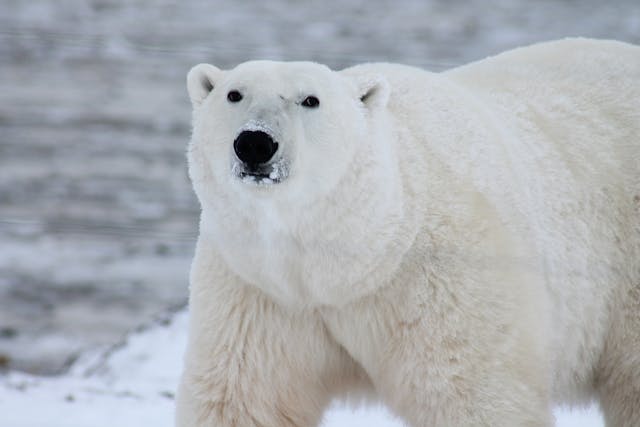
How do polar bears find enough food? By having an exceptional sense of smell, a lot of patience, and a very efficient digestion.
Polar bears are the largest bear species by far. An adult male can weigh close to 800 kg, and they are about 160 cm at the shoulder. When they stand up and stretch out their forearms, they can be over 3 m tall. The females are not as large, but all polar bears need to eat a lot every day to stay alive. Brown bears and other bears eat anything. They are technically carnivores, but they have an omnivore diet. They will eat meat and fish to get the fat and the protein, but they also eat plants, berries, fruit, and anything else they can get their paws on. In their habitats, bears have an abundant source of food. They generally don’t have any trouble fattening themselves up for hibernation. Polar bears don’t have the same opportunities.
Polar bears are more carnivorous than the other bears because meat gives them a greater source of protein and fat. They eat seals, walruses, narwhals, and whales if they can get them. They eat reindeer, small mammals, birds, and eggs. They will eat plants and berries as well, if they are available, but they are not for most of the year. An adult male polar bear needs to eat about 2 kg of fat a day to sustain themselves. They need to stay warm in the coldest parts of the winter and they need a layer of fat to do that. They have an incredibly warm coat, but they need fat as well. They have two layers of fur, an outer layer and an inner layer, that keep the heat in, but the layer of fat keeps them insulated when they dive into the sea in search of prey.
Polar bears need 2 kg of fat a day, but they cannot find food every single day. Their bodies have had to adapt to be able to eat a lot when there is food. Their stomachs will stretch to an enormous volume and a polar bear can eat up to 70 kg of food in one sitting. That is enough food to last them a week or more. Their digestive system is also incredibly efficient, and they can absorb 84% of the protein and 97% of the fats that they eat. A seal weighs about 60 kg, so if a polar bear can kill and eat a seal a week, they will be ok. Mammals that live in the cold seas have a lot of fat and polar bears will eat mostly fat, leaving the rest of the meat for other animals.
So, how do polar bears find enough food? Well, the first way is hunting. Polar bears are exceptional swimmers, but they can’t capture a seal in the water. They know what seal breathing holes look like and they wait patiently next to those. When a seal comes up to breathe, they will grab the seal and pull it out onto the snow where they can eat it. They stalk seals that are sunning themselves on the ice as well. If they can catch one, they have a good chance of killing it. They prey on seal pups as well. Many mammals in the arctic give birth in a den dug into a snowbank because it is much warmer. Polar bears do this as well. Because of their incredible sense of smell, the polar bears can smell where the seal pups are and they can break through the roof of the den to get to them.
They eat larger mammals as well, such as walruses and whales, but they can’t pull those out of the water. They usually feed on dead whales that have been beached. Their incredibly strong sense of smell allows them to smell a dead whale from over 30 km away.
They are opportune hunters because they don’t have the chances to find food that bears living in woods do. They obviously prefer seals and mammals with a lot of blubber, but they will eat whatever they can get. They eat fish, shellfish, and anything else that lives in the sea. They eat rodents and hares that live on the snow. They can easily kill caribou and muskox, but they usually can’t catch the adult or healthy ones, so they eat the young or sick, if they can get them. A muskox is an ox that lives in the arctic. A polar bear can run at 30 km/h, but caribou and muskox can run at up to 60 km/h. Polar bears have a thick coat to keep them warm in the cold, but that means they can’t run for long because they overheat easily. They will also eat eggs and whatever fruit or plants grow in the summer in the arctic, but that is not enough to sustain them. Polar bears need fat, and lots of it. And this is what I learned today.
Photo by Pixabay: https://www.pexels.com/photo/close-photography-of-white-polar-bear-53425/
Sources
https://www.arcticwwf.org/wildlife/polar-bear/polar-bear-diet
https://seaworld.org/animals/all-about/polar-bear/diet
https://www.nwf.org/Educational-Resources/Wildlife-Guide/Mammals/Polar-Bear
https://www.nathab.com/blog/polar-bear-story-do-polar-bears-hibernate
https://www.nationalgeographic.com/animals/mammals/facts/polar-bear
https://www.nathab.com/blog/polar-bear-story-what-do-polar-bears-eat
